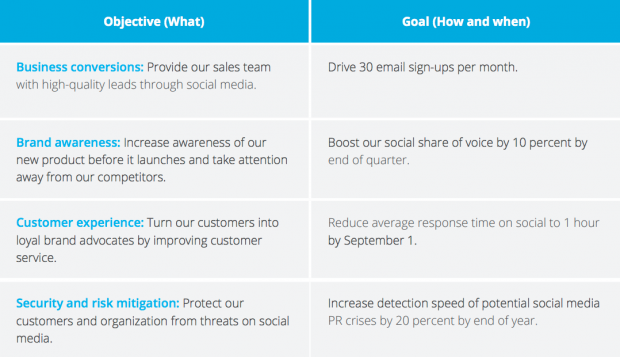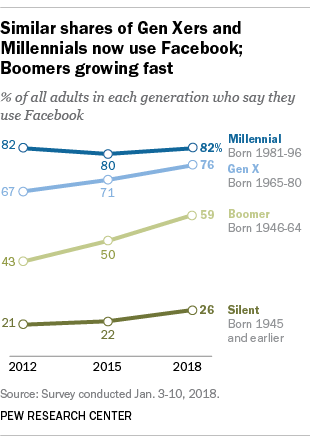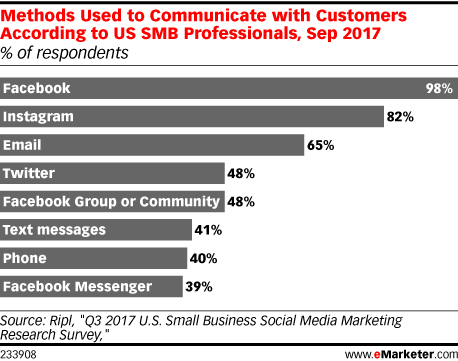How to Create a Social Media Marketing Strategy in 8 Easy Steps
A social media marketing strategy is a summary of everything you plan to do and hope to achieve on social media. It guides your actions and lets you know whether you’re succeeding or failing. Every post, reply, like, and comment should serve a purpose.
The more specific your strategy is, the more effective the execution will be. Keep it concise. Don’t make your plan so lofty and broad that it’s unattainable or impossible to measure.
In this post, we’ll walk you through an eight-step plan to create a winning social media marketing plan of your own.
Bonus: Get a free social media strategy template to quickly and easily plan your own strategy. Also use it to track results and present the plan to your boss, teammates, and clients.
How to create a social media strategy
Step 1. Set social media marketing goals that align to business objectives
Set S.M.A.R.T. goals
The first step to creating a winning strategy is to establish your objectives and goals. Without goals, you have no way to measure success or return on investment (ROI).
Each of your goals should be:
- Specific
- Measurable
- Attainable
- Relevant
- Time-bound
This is the S.M.A.R.T. goal framework. It will guide your actions and ensure they lead to real business results.
Track meaningful metrics
Vanity metrics like retweets and likes are easy to track, but it’s hard to prove their real value. Instead, focus instead on targets such as leads generated, web referrals, and conversion rate.
For inspiration, take a look at these 19 social media metrics and why you should track them.
You may want to track different goals for different channels, or even different uses of each channel. For example, Benefit Cosmetics drives brand awareness with its paid social campaigns, but measures acquisition and engagement for organic social posts.
View this post on InstagramCAPTION THIS!???????????? Best answers might just win a #benefit package! #hoola
Make sure to align your social media goals with your overall marketing strategy. This will make it easier for you to show the value of your work and get executive buy-in and investment.

Start developing your social media marketing plan by writing down at least three goals for social media.
Step 2. Learn everything you can about your audience
Create audience personas
Knowing who your audience—and ideal customer—is and what they want to see on social is key to creating content that they will like, comment on, and share. It’s also critical if you want to turn social media followers into customers for your business.
Try creating audience/buyer personas. These allow you to think of your potential fans, followers, and customers as real people with real wants and needs. And that will allow you to think more clearly about what to offer them.
Gather real-world data
Don’t make assumptions. Think Facebook is a better network for reaching Baby Boomers than Millennials? Well, the numbers show that Millennials still outnumber Boomers on the platform.

Social media analytics can also provide a ton of valuable information about who your followers are, where they live, which languages they speak, and how they interact with your brand on social. These insights allow you to refine your strategy and better target your social ads.
Jugnoo, an Uber-like service for auto-rickshaws in India, used Facebook Analytics to learn that 90 percent of their users who referred other customers were between 18- and 34-years-old, and 65 percent of that group was using Android. They used that information to target their ads, resulting in a 40 percent lower cost per referral.
Check out our guide to using social media analytics and the tools you need to track them.
Step 3. Research the competition
Odds are, your competitors are already using social media—and that means you can learn from what they’re already doing.
Conduct a competitive analysis
A competitive analysis allows you to understand who the competition is and what they’re doing well (and not so well). You’ll get a good sense of what’s expected in your industry, which will help you set social media targets of your own.
This analysis will also help you spot opportunities. For example, maybe one of your competitors is dominant on Facebook, but has put little effort into Twitter or Instagram. You might want to focus on the networks where your audience is underserved, rather than trying to win fans away from a dominant player.
Engage in social listening
Social listening is another way to keep an eye on the competition. Here’s how to use Hootsuite streams for social listening and monitoring competitors:
As you track competitor accounts and relevant industry keywords, you may notice shifts in the way these channels are used. Or, you might spot a specific post or campaign that really hits the mark—or totally bombs. Keep an eye on this information and use to it evaluate your own goals and plans.
Step 4. Conduct a social media audit
Examine your current efforts
If you’re already using social media tools, you need to take a step back and look at what you’ve already done and accomplished. Ask yourself the following questions:
- What’s working, and what’s not?
- Who is connecting with you on social?
- Which networks does your target audience use?
- How does your social media presence compare to that of your competitors?
Once you gather all this information in one place, you’ll have a good starting point for planning how to improve your results.
We’ve created a social media audit template that you can follow for each step of the process.

Your audit should give you a clear picture of what purpose each of your social accounts serves. If the purpose of an account isn’t clear, think about whether it’s worth keeping.
To help you decide, ask yourself the following questions:
- Is my audience here?
- If so, how are they using this platform?
- Can I use this account to help achieve meaningful business goals
Asking these tough questions will help keep your strategy on track and focused.
Look for impostor accounts
During the audit you may discover fraudulent accounts using your business name or the names of your products.
These imposters can be harmful to your brand, never mind capturing followers that should be yours. Report them. You may want to get your Facebook and Twitter accounts verified to ensure your fans and followers know they are dealing with the real you.
Step 5. Set up accounts and improve existing profiles
Determine which networks to use (and how to use them)
As you decide which social channels to use, you will also need to define your strategy for each network.
For example, Benefit Cosmetics’ social media manager, Angela Purcaro, told eMarketer: “For our makeup tutorials … we’re all about Snapchat and Instagram Stories. Twitter, on the other hand, is designated for customer service.”
For reference, here’s how other small and medium-sized businesses are using social tools to communicate with customers. Notice that Facebook and Instagram outrank even email for this purpose.

It’s a good exercise to create mission statements for each network. These one-sentence declarations will help you focus on a very specific goal for each account on each social network.
Example: “We will use Facebook advertising to target a specific audience in order to increase sales.” One more: “We will use Instagram for promoting and sharing our company culture to help with recruitment and employee advocacy.”
If you can’t create a solid mission statement for a particular social network, you may want to reconsider whether that network is worth it.
Set up (and optimize) your accounts
Once you’ve decided which networks to focus on, it’s time to create your profiles—or improve existing profiles so they align with your strategic plan.
- Make sure you fill out all profile fields
- Use keywords people will use to search for your business
- Use images that are correctly sized for each network
Here’s a quick overview of how to get your social media profiles into tip-top shape:
We’ve also got step-by-step guides for each network to walk you through the process:
- Create a Facebook business page
- Create an Instagram business account
- Create a Twitter business account
- Create a Snapchat account
- Create a LinkedIn Company Page
- Create a Pinterest business account
- Create a YouTube channel
- Create a WeChat business account
Don’t let this list overwhelm you. Remember, it’s better to use fewer channels well than to stretch yourself thin trying to maintain a presence on every network.
Bonus: Get a free social media strategy template to quickly and easily plan your own strategy. Also use it to track results and present the plan to your boss, teammates, and clients.
Get the free template now!Step 6. Find inspiration
While it’s important that your brand be unique, you can still draw inspiration from other businesses that are great on social.
Social network success stories
You can usually find these on the business section of the social network’s website. (Here’s Facebook’s, for example.)
These case studies can offer valuable insights you can apply to your own goals for each social network.
Award-winning accounts and campaigns
You could also check out the winners of The Facebook Awards or The Shorty Awards for examples of brands that are at the top of their social media game.
Your favorite brands on social media.
Who do you enjoy following on social media? What do they do that compels people to engage and share their content?
National Geographic, for example, is one of the best on Instagram, combining stunning visuals with compelling captions.
View this post on Instagram
Then there’s Shopify. The ecommerce brand uses Facebook to sell themselves by showcasing customer stories and case studies.
And IKEA is a great example of superior customer service on Twitter. They use their 280 characters to solve problems and answer questions—often with a bit of humor.
That's not the right type of smashing delivery service that we like to see… Please DM us your order number, full name, address and contact info so we can assist you. – CB https://t.co/XBb8cj5asL
— IKEAIESupport (@IKEAIESupport) March 12, 2019
Notice that each of these accounts has a consistent voice, tone, and style. Consistency is key to helping your followers understand what to expect from your brand. They’ll know why they should continue to follow you and what value they will get from doing so. It also helps keep your branding consistent even when you have multiple people working on your social team.
Check our how-to guide on establish a compelling and consistent brand ‘voice’ on social media.
Ask your followers
Consumers can also offer social media inspiration. What are your target customers talking about online? What can you learn about their wants and needs? If you have existing social channels, you could also ask your existing followers what they want from you. Just make sure that you follow through and deliver what they ask for.
Step 7. Create a social media content calendar
Sharing great content is essential, of course, but it’s equally important to have a plan in place for when you’ll share content to get the maximum impact. Your social media content calendar also needs to account for the time you’ll spend interacting with the audience (although you need to allow for some spontaneous engagement as well).
Create a posting schedule
Your social media content calendar lists the dates and times at which you will publish types of content on each channel. It’s the perfect place to plan all of your social media activities—from images and link sharing to blog posts and videos. It includes both your day-to-day posting and content for social media campaigns. Your calendar ensures your posts are spaced out appropriately and published at the optimal times.
Plot your content mix
Make sure your calendar reflects the mission statement you’ve assigned to each social profile, so that everything you post is working to support your business goals. For example, you might decide that:
- 50 percent of content will drive traffic back to your blog
- 25 percent of content will be curated from other sources
- 20 percent of content will support enterprise goals (selling, lead generation, etc.)
- 5 percent of content will be about HR and company culture
Placing these different post types in your content calendar will help ensure you maintain the ratio you’ve planned. If you’re starting from scratch and you’re simply not sure what types of content to post, try the 80-20 rule:
- 80 percent of your posts should inform, educate, or entertain your audience
- 20 percent can directly promote your brand.
You could also try the social media rule of thirds:
- One-third of your social content promotes your business, converts readers, and generates profit.
- One-third of your social content shares ideas and stories from thought leaders in your industry or like-minded businesses.
- One-third of your social content involves personal interactions with your audience.
Once you have your calendar set, use scheduling tools or bulk scheduling to prepare your messaging in advance rather than updating constantly throughout the day. This allows you to craft the language and format of your posts rather than writing them on the fly whenever you have time.
Step 8. Test, evaluate, and adjust your strategy
Your social media strategy is a hugely important document for your business, and you can’t assume you’ll get it exactly right on the first try. As you start to implement your plan and track your results, you may find that some strategies don’t work as well as you’d anticipated, while others are working even better than expected.
Track your data
In addition to the analytics within each social network (see Step 2), you can use UTM parameters to track social visitors as they move through your website, so you can see exactly which social posts drive the most traffic to your website.
Re-evaluate, test, and do it all again
Once this data starts coming in, use it to re-evaluate your strategy regularly. You can also use this information to test different posts, campaigns, and strategies against one another. Constant testing allows you to understand what works and what doesn’t, so you can refine your strategy in real time.
Surveys can also be a great way to find out how well your strategy is working. Ask your followers, email list, and website visitors whether you’re meeting their needs and expectations, and what they’d like to see more of. Then make sure to deliver on what they tell you.
In the social sphere, things change fast. New networks emerge, while others go through significant demographic shifts. Your business will go through periods of change as well. All of this means that your social media strategy should be a living document that you look at regularly and adjust as needed. Refer to it often to keep you on track, but don’t be afraid to make changes so that it better reflects new goals, tools, or plans.
When you update your social strategy, make sure to let everyone on your team know. That way they can all work together to help your business make the most of your social media accounts.
Social media strategy template
Bonus: Get a free social media strategy template to quickly and easily plan your own strategy. Also use it to track results and present the plan to your boss, teammates, and clients.
Once you’ve mapped out your social media marketing plan, use Hootsuite to schedule all of your social media posts, engage with your followers, and measure performance. Try it for free.
Once you’ve mapped out your social media marketing plan, use Hootsuite to schedule all of your social media posts, engage with your followers, and measure performance.Get Started for FreeThe post How to Create a Social Media Marketing Strategy in 8 Easy Steps appeared first on Hootsuite Social Media Management.
Contributer : Hootsuite Social Media Management https://ift.tt/1IZGJTH
 Reviewed by mimisabreena
on
Thursday, March 14, 2019
Rating:
Reviewed by mimisabreena
on
Thursday, March 14, 2019
Rating:















No comments:
Post a Comment